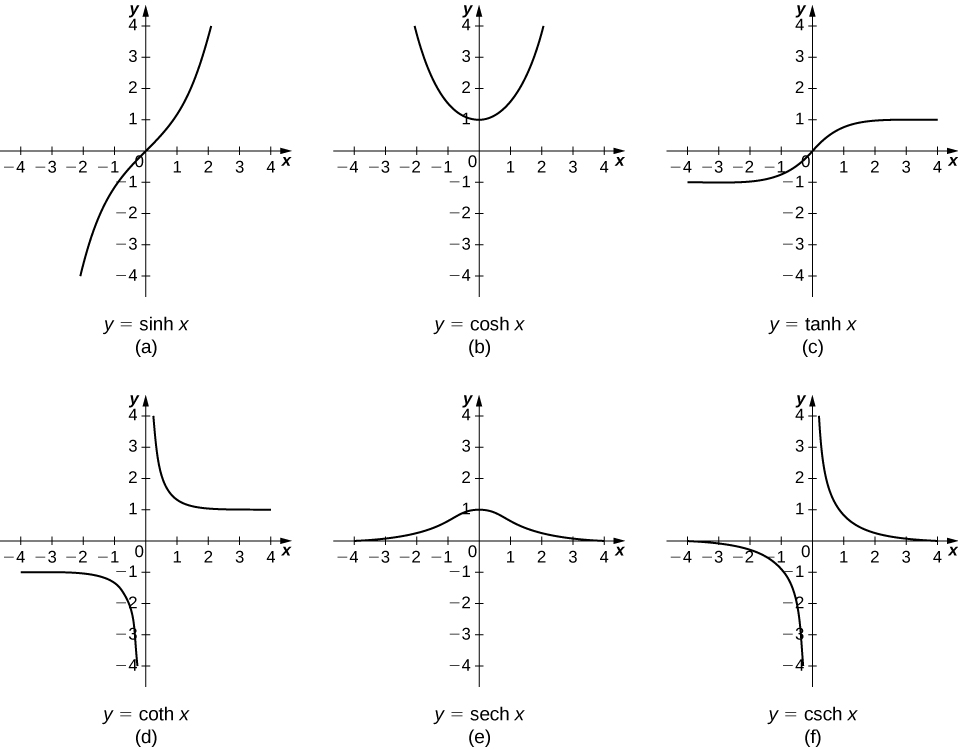- Differentiate and integrate hyperbolic functions and their inverse forms
- Understand the practical situations where the catenary curve appears
Derivatives and Integrals of the Hyperbolic Functions
The hyperbolic sine ([latex]sinh[/latex]) and hyperbolic cosine ([latex]cosh[/latex]) functions are defined as:
The other hyperbolic functions are then defined in terms of [latex]\text{sinh}x[/latex] and [latex]\text{cosh}x.[/latex] The graphs of these functions provide insights into their behaviors.

It is straightforward to develop differentiation formulas for hyperbolic functions. For instance:
Similarly, [latex](\frac{d}{dx})\text{cosh}x=\text{sinh}x.[/latex]
derivatives of the hyperbolic functions
| [latex]f(x)[/latex] | [latex]\frac{d}{dx}f(x)[/latex] |
|---|---|
| [latex]\text{sinh}x[/latex] | [latex]\text{cosh}x[/latex] |
| [latex]\text{cosh}x[/latex] | [latex]\text{sinh}x[/latex] |
| [latex]\text{tanh}x[/latex] | [latex]{\text{sech}}^{2}x[/latex] |
| [latex]\text{coth}x[/latex] | [latex]\text{−}{\text{csch}}^{2}x[/latex] |
| [latex]\text{sech}x[/latex] | [latex]\text{−}\text{sech}x\text{tanh}x[/latex] |
| [latex]\text{csch}x[/latex] | [latex]\text{−}\text{csch}x\text{coth}x[/latex] |
The derivatives of hyperbolic functions share similarities with those of trigonometric functions. For example:
[latex](\frac{d}{dx}) \sin x= \cos x[/latex] and [latex](\frac{d}{dx})\text{sinh}x=\text{cosh}x.[/latex]
However, the derivatives of the cosine functions differ in sign:
[latex](\frac{d}{dx}) \cos x=\text{−} \sin x,[/latex] but [latex](\frac{d}{dx})\text{cosh}x=\text{sinh}x.[/latex]
Using the differentiation formulas, we can derive the integral formulas for hyperbolic functions.
integral formulas for hyperbolic functions
[latex]\begin{array}{cccccccc}\hfill \displaystyle\int \text{sinh}udu& =\hfill & \text{cosh}u+C\hfill & & & \hfill \displaystyle\int {\text{csch}}^{2}udu& =\hfill & \text{−}\text{coth}u+C\hfill \\ \hfill \displaystyle\int \text{cosh}udu& =\hfill & \text{sinh}u+C\hfill & & & \hfill \displaystyle\int \text{sech}u\text{tanh}udu& =\hfill & \text{−}\text{sech}u+C\hfill \\ \hfill \displaystyle\int {\text{sech}}^{2}udu& =\hfill & \text{tanh}u+C\hfill & & & \hfill \displaystyle\int \text{csch}u\text{coth}udu& =\hfill & \text{−}\text{csch}u+C\hfill \end{array}[/latex]
Evaluate the following derivatives:
- [latex]\frac{d}{dx}(\text{sinh}({x}^{2}))[/latex]
- [latex]\frac{d}{dx}{(\text{cosh}x)}^{2}[/latex]
Evaluate the following integrals:
- [latex]\displaystyle\int x\text{cosh}({x}^{2})dx[/latex]
- [latex]\displaystyle\int \text{tanh}xdx[/latex]